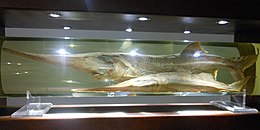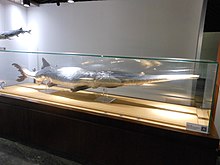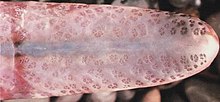
Yangtze or Yangzi is the longest river in Eurasia, the third-longest in the world, and the longest in the world to flow entirely within one country. It rises at Jari Hill in the Tanggula Mountains of the Tibetan Plateau and flows 6,300 km (3,915 mi) in a generally easterly direction to the East China Sea. It is the fifth-largest primary river by discharge volume in the world. Its drainage basin comprises one-fifth of the land area of China, and is home to nearly one-third of the country's population.
Sturgeon is the common name for the 28 species of fish belonging to the family Acipenseridae. The earliest sturgeon fossils date to the Late Cretaceous, and are descended from other, earlier acipenseriform fish, which date back to the Early Jurassic period, some 174 to 201 million years ago. They are one of two living families of the Acipenseriformes alongside paddlefish (Polyodontidae). The family is grouped into four genera: Acipenser, Huso, Scaphirhynchus, and Pseudoscaphirhynchus. Two species may be extinct in the wild, and one may be entirely extinct. Sturgeons are native to subtropical, temperate and sub-Arctic rivers, lakes and coastlines of Eurasia and North America. A Maastrichtian-age fossil found in Morocco shows that they also once lived in Africa.

Acipenseriformes is an order of basal ray-finned fishes that includes living and fossil sturgeons and paddlefishes (Acipenseroidei), as well as the extinct families Chondrosteidae and Peipiaosteidae. They are the second earliest diverging group of living ray-finned fish after the bichirs. Despite being early diverging, they are highly derived, having only weakly ossified skeletons that are mostly made of cartilage, and in modern representatives highly modified skulls.

Paddlefish are a family of ray-finned fish belonging to order Acipenseriformes, and one of two living groups of the order alongside sturgeons (Acipenseridae). They are distinguished from other fish by their elongated rostra, which are thought to enhance electroreception to detect prey. Paddlefish have been referred to as "primitive fish" because the Acipenseriformes are among the earliest diverging lineages of ray-finned fish, having diverged from all other living groups over 300 million years ago. Paddlefish are almost exclusively North American and Chinese, both extant and in the fossil record.

The American paddlefish is a species of ray-finned fish. It is the last living species of paddlefish (Polyodontidae). This family is most closely related to the sturgeons; together they make up the order Acipenseriformes, which are one of the most primitive living groups of ray-finned fish. Fossil records of other paddlefish species date back 125 million years to the Early Cretaceous, with records of Polyodon extending back 65 million years to the early Paleocene. The American paddlefish is a smooth-skinned freshwater fish with an almost entirely cartilaginous skeleton and a paddle-shaped rostrum (snout), which extends nearly one-third its body length. It has been referred to as a freshwater shark because of its heterocercal tail or caudal fin resembling that of sharks, though it is not closely related. The American paddlefish is a highly derived fish because it has evolved specialised adaptations such as filter feeding. Its rostrum and cranium are covered with tens of thousands of sensory receptors for locating swarms of zooplankton, its primary food source. The only other species of paddlefish that survived to modern times was the Chinese paddlefish, last sighted in 2003 in the Yangtze River in China and considered to have gone extinct no later than 2010.

The kaluga, also known as the river beluga, is a large predatory sturgeon found in the Amur River basin. With a maximum size of at least 1,000 kg (2,205 lb) and 5.6 m (18.6 ft), the kaluga is one of the biggest of the sturgeon family. Like the slightly larger beluga, it spends part of its life in salt water. Unlike the beluga, this fish has 5 major rows of dermal scutes and feeds on salmon and other fish in the Amur. They have gray-green to black backs with a yellowish green-white underbelly.
The Chinese sturgeon is a critically endangered member of the family Acipenseridae in the order Acipenseriformes. Historically, this anadromous fish was found in China, Japan, and the Korean Peninsula, but it has been extirpated from most regions due to habitat loss and overfishing.

White sturgeon is a species of sturgeon in the family Acipenseridae of the order Acipenseriformes. They are an anadromous (migratory) fish species ranging in the Eastern Pacific; from the Gulf of Alaska to Monterey, California. However, some are landlocked in the Columbia River Drainage, Montana, and Lake Shasta in California, with reported sightings in northern Baja California, Mexico.
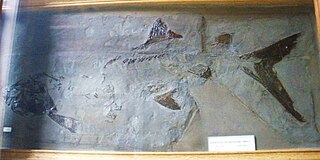
Chondrosteus is a genus of extinct actinopterygian belonging to the family Chondrosteidae. It lived during the Sinemurian in what is now England. Chondrosteus is related to sturgeons and paddlefishes as part of the clade Acipenseriformes. Similar to sturgeons, the jaws of Chondrosteus were free from the rest of the skull. Its scale cover was reduced to the upper lobe of the caudal fin like in paddlefish.

Dabry's sturgeon, also known as the Yangtze sturgeon, Changjiang sturgeon and river sturgeon, is a species of fish in the sturgeon family, Acipenseridae. It is endemic to China and today restricted to the Yangtze River basin, but was also recorded from the Yellow River basin in the past. It was a food fish of commercial importance. Its populations declined drastically, and since 1988, it was designated an endangered species on the Chinese Red List in Category I and commercial harvest was banned. It has been officially declared extinct in the wild by the IUCN as of July 21, 2022.

The Russian sturgeon, also known as the diamond sturgeon or Danube sturgeon, is a species of fish in the family Acipenseridae. It is found in Azerbaijan, Bulgaria, Georgia, Iran, Kazakhstan, Romania, Russia, Turkey, Turkmenistan, and Ukraine. It is also found in the Caspian Sea. This fish can grow up to about 235 cm (93 in) and weigh 115 kg (254 lb). Russian sturgeon mature and reproduce slowly, making them highly vulnerable to fishing. It is distinguished from other Acipenser species by its short snout with a rounded tip as well as its lower lip which is interrupted at its center.
Paleopsephurus is an extinct genus of paddlefish (Polyodontidae). At present the genus contains the single species Paleopsephurus wilsoni. The genus is known from the Late Cretaceous (Maastrichtian) aged Hell Creek Formation of Montana.

Strongylosteus is an extinct genus of prehistoric ray-finned fish that lived during the early Toarcian age of the Early Jurassic epoch. Its type species is Strongylosteus hindenburgi (monotypy). It is related to modern sturgeon and paddlefish (Acipenseroidei), but with a different kind of mouth than common species, made for hunting prey in open waters, with a strong lower jaw, similar to modern beluga sturgeon.
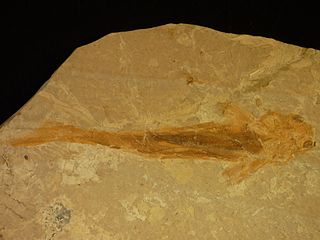
Peipiaosteus is an extinct genus of prehistoric chondrostean ray-finned fish. Its fossils are found in the Early Cretaceous Jiufotang Formation, Pani Lake, Liaoning Province, China.

Protopsephurus is an extinct genus of paddlefish containing the single species Protopsephurus liui, known from the Yixian Formation in Liaoning, northern China from the Barremian to Aptian ages of the Early Cretaceous period around 125-120 million years ago. It is currently the oldest and most basal paddlefish known.
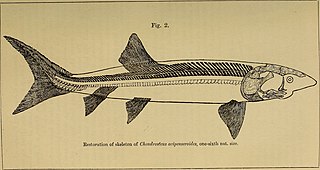
Chondrosteidae is a family of extinct marine actinopterygian fishes, known from the Early Jurassic of Europe. They are closely related to modern sturgeons and paddlefish of the order Acipenseriformes, and are either placed as part of that order or the separate order Chondrosteiformes within the Chondrostei. Three genera are known, Chondrosteus, Gyrosteus, and Strongylosteus. Included species were of large size, with body lengths ranging from 2 metres (6.6 ft) up to 7 metres (23 ft). Their skeleton was largely made up of bones, but ossification was reduced compared to other ray-fins.

Crossopholis is an extinct fish known from the early Eocene (Ypresian) of North America, approximately 52 million years ago. It is a close relative of the contemporary American paddlefish, belonging to the paddlefish family Polyodontidae.

The sturddlefish is a hybrid of the American paddlefish and the Russian sturgeon, accidentally created by researchers in 2019 and announced in 2020. Obtaining living hybrids through breeding individuals from different families is unusual, especially given that the two species' last common ancestor lived 184 million years ago. The hybrids were created accidentally during attempts to induce gynogenesis, a type of parthenogenic reproduction where a sperm cell must be present to trigger embryogenesis but does not genetically contribute to the offspring. Hundreds of hybrid fish were created, of which about two-thirds survived over one month, and about 100 survived for one year. As of July 2020, all living hybrid fish are living in captivity at the research lab in Hungary. There are no current plans to create new sturddlefish.
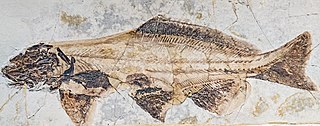
Peipiaosteidae is an extinct family of fish, known from the Late Jurassic and Early Cretaceous of Asia. They are members of Acipenseriformes, related to sturgeons (Acipenseridae) and paddlefish (Polyodontidae). Fossils have been found in freshwater deposits in China, Russia, Kazakhstan, and Mongolia. They are generally considered either the earliest diverging group of Acipenseriformes, or the sister group to the clade containing Acipenseridae and Polyodontidae. At least Yanosteus was likely to have been piscivorous, based on a specimen of Lycoptera found in the mouth of one specimen.
Parapsephurus is an extinct genus of paddlefish in the family Polyodontidae. Currently the only known species in this genus is the type species, Parapsephurus willybemisi.P. willybemisi is known a nearly complete specimen from the Tanis locality of the Hell Creek Formation in North Dakota, USA, which dates to the late Maastrichtian stage of the Late Cretaceous, approximately 66 million years ago.
